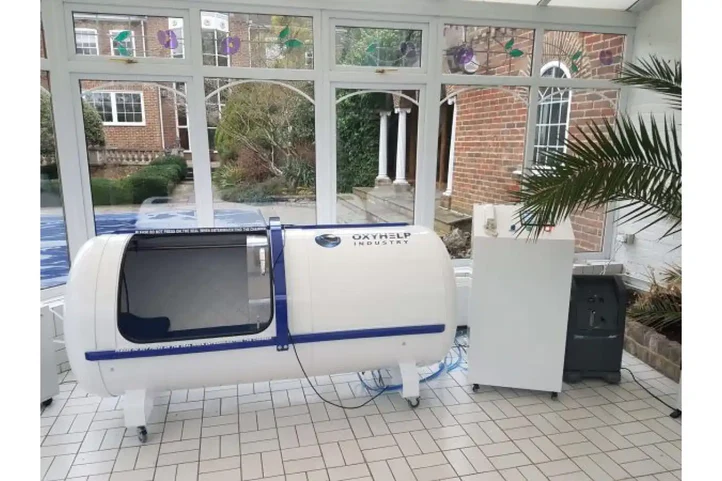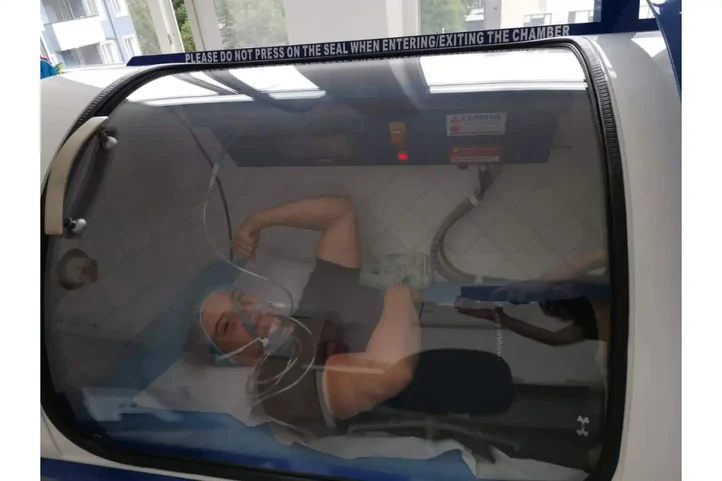Before using a hyperbaric chamber, it is important to understand what it is and how it works. A hyperbaric chamber is a medical device that delivers oxygen at increased pressure levels, allowing your body to absorb more oxygen than normal. This can help with various conditions, such as decompression sickness, carbon monoxide poisoning, and non-healing wounds.
Explanation of hyperbaric chambers
A hyperbaric chamber is a sealed, pressurized chamber in which the patient breathes pure oxygen. The increased pressure forces more oxygen into the bloodstream, which can help promote healing and reduce inflammation. Hyperbaric chambers are typically used as part of a treatment plan for conditions such as gas embolism, severe anemia, and radiation injury.
There are two main types of hyperbaric chambers: monoplane and multiple. Monoplace chambers are designed for one person at a time, while various chambers can accommodate numerous people. The chamber is typically made of sturdy materials, such as steel or acrylic, with windows to allow the patient to see outside.
Before using a hyperbaric chamber, it is important to consult with a healthcare provider to determine if it is appropriate for your specific condition and to ensure that you are a good candidate for hyperbaric oxygen therapy. Your healthcare provider will also discuss the risks and benefits of using a hyperbaric chamber and any precautions you may need to take.

Brief overview of hyperbaric oxygen therapy
Hyperbaric oxygen therapy (HBOT) involves breathing pure oxygen in a pressurized chamber. The increased oxygen levels in the bloodstream can help promote healing and reduce inflammation. HBOT is commonly used for conditions such as decompression sickness, carbon monoxide poisoning, increase hair growth and non-healing wounds.
During a hyperbaric oxygen therapy session, you will be asked to lie or sit comfortably inside the chamber. The chamber will then be pressurized with pure oxygen, which you will breathe through a mask or hood. The session typically lasts for about 1-2 hours, during which time you may experience a feeling of fullness in your ears, similar to the sensation felt when flying on an airplane or driving up a mountain.
Understanding Hyperbaric Chambers
Hyperbaric chambers deliver oxygen at increased pressure levels, allowing the body to absorb more oxygen than normal. This process can help with various medical conditions and promote healing. The chamber is a sealed, pressurized environment where the patient breathes pure oxygen. The increased pressure forces more oxygen into the bloodstream, which can aid in reducing inflammation and promoting tissue repair.
Before using a hyperbaric chamber, it is important to understand the risks and benefits associated with hyperbaric oxygen therapy. Some potential dangers include ear barotrauma (pressure-related ear injuries), changes in vision, and oxygen toxicity. It is also important to ensure that you are a good candidate for hyperbaric oxygen therapy and that your healthcare provider has determined it appropriate for your specific condition.
Additionally, it is important to be aware of any potential contraindications to using a hyperbaric chamber. For example, individuals with certain medical conditions such as untreated pneumothorax (collapsed lung), untreated high fever, or certain types of chemotherapy may not be suitable candidates for hyperbaric oxygen therapy.
Types of hyperbaric chambers
Several types of hyperbaric chambers may be used for hyperbaric oxygen therapy. The two main categories of hyperbaric chambers are monoplane and multi-place chambers.
Monoplace chambers are designed to accommodate only one person at a time. These chambers are typically clear acrylic tubes or pods, allowing patients to lie comfortably while receiving treatment. Monoplace chambers like summit to sea hyperbaric chamber are often used for outpatient treatments and are suitable for individuals with claustrophobia or mobility issues.
Multiplace chambers, on the other hand, can accommodate multiple patients at once. These chambers are typically large metal compartments resembling a room with several people sitting. Multiplace chambers are often used in hospital settings where multiple patients may require hyperbaric oxygen therapy simultaneously. These chambers are suitable for patients who may require assistance during the treatment or for those who need constant monitoring by healthcare providers.
How do hyperbaric chambers work?
Hyperbaric chambers deliver oxygen at increased pressure levels, allowing the body to absorb more oxygen than normal. When a patient enters a hyperbaric chamber, the chamber is pressurized with pure oxygen, typically at levels higher than atmospheric pressure. This increase in pressure forces more oxygen into the bloodstream, which can help promote healing and reduce inflammation in the body.
As the patient breathes in pure oxygen, it is carried throughout the body, reaching areas with limited blood flow or reduced oxygen levels. This increased oxygen delivery can help stimulate the production of new blood vessels, reduce swelling, and promote tissue repair.
Hyperbaric chambers are commonly used to treat a variety of medical conditions, including wounds that are slow to heal (such as diabetic foot ulcers), carbon monoxide poisoning, decompression sickness (the bends), and radiation injuries. They can also be adjunctive therapy for certain infections, burns, and chronic non-healing wounds.
Explanation of how hyperbaric chambers increase atmospheric pressure
Hyperbaric chambers are designed to increase the atmospheric pressure inside the chamber to levels higher than normal. This increase in pressure allows for a greater concentration of oxygen to be delivered to the body, which can have therapeutic benefits.
Increasing atmospheric pressure in a hyperbaric chamber is achieved by sealing the chamber and gradually introducing compressed air or pure oxygen. The pressure inside the chamber slowly rises to the desired level, typically 1.5 to 3 times higher than atmospheric pressure at sea level. This increase in pressure forces more oxygen molecules into the bloodstream, which can help improve oxygen delivery to tissues and organs throughout the body.
As the patient breathes in pressurized air or oxygen, the oxygen dissolves into the plasma. It is delivered to areas of the body with limited blood flow or reduced oxygen levels. This increased oxygen delivery can help promote healing, reduce inflammation, and support the body’s natural healing processes.

Medical Conditions Treated with Hyperbaric Oxygen Therapy
Hyperbaric oxygen therapy treats various medical conditions that benefit from increased oxygen delivery to tissues and organs. Some of the common medical conditions treated with hyperbaric oxygen therapy include:
- Wounds that are slow to heal: Hyperbaric oxygen therapy can help promote healing in wounds that have difficulty healing, such as diabetic foot ulcers, venous ulcers, and pressure ulcers.
- Carbon monoxide poisoning: Hyperbaric oxygen therapy can help remove carbon monoxide from the bloodstream and tissues, reducing the risk of tissue damage and promoting recovery.
- Decompression sickness: Also known as “the bends,” decompression sickness occurs when nitrogen bubbles form in the bloodstream and tissues after rapid changes in pressure, such as scuba diving. Hyperbaric oxygen therapy can help reduce the size of these bubbles and alleviate symptoms.
- Radiation injuries: Hyperbaric oxygen therapy can help promote tissue repair and reduce inflammation in patients who have experienced radiation injuries, such as radiation-induced soft tissue necrosis.
- Certain infections: Hyperbaric oxygen therapy can help enhance the body’s immune response and improve oxygen delivery to infected tissues, making it an effective adjunctive treatment for necrotizing fasciitis, gas gangrene, and osteomyelitis.
- Burns: Hyperbaric oxygen therapy can help improve wound healing in burn patients by promoting tissue repair, reducing inflammation, and enhancing the body’s natural healing processes.
- Chronic non-healing wounds: Hyperbaricxygen therapy can be an adjunctive therapy for chronic non-healing wounds, such as pressure ulcers, venous ulcers, and diabetic foot ulcers. By increasing oxygen delivery to the affected tissues, hyperbaric oxygen therapy can help promote healing and reduce the risk of infection.
Decompression sickness
Decompression sickness, also known as “the bends,” is a condition that can occur when nitrogen bubbles form in the bloodstream and tissues after rapid changes in pressure, such as scuba diving. The increased atmospheric pressure inside a hyperbaric chamber can help alleviate symptoms of decompression sickness by reducing the size of these bubbles and promoting their elimination from the body.
During hyperbaric oxygen therapy for decompression sickness, patients may experience relief from symptoms such as joint pain, fatigue, dizziness, and shortness of breath. The pressurized environment of the hyperbaric chamber helps to increase oxygen levels in the blood and tissues, speeding up the elimination of nitrogen bubbles and improving overall oxygen delivery to affected areas.
Description and treatment using hyperbaric oxygen therapy
Hyperbaric oxygen therapy involves the use of a hyperbaric chamber, which is a pressurized chamber that allows patients to breathe in pure oxygen at higher-than-normal atmospheric pressure levels. This pressurized environment helps increase the amount of oxygen that can dissolve into the bloodstream, promoting healing and reducing inflammation in various medical conditions.
During a hyperbaric oxygen therapy session, patients typically lie down inside the chamber and breathe in 100% oxygen through a mask or hood. The pressure inside the chamber is gradually increased to two to three times higher than normal atmospheric pressure levels, allowing for greater oxygen absorption into the bloodstream.
The length and frequency of hyperbaric oxygen therapy sessions can vary depending on the patient’s condition and the severity of their symptoms. Some patients may require multiple sessions over several weeks, while others may only need a few sessions to see improvement.

